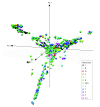Association Between Mitochondrial DNA Haplogroup Variation and Autism Spectrum Disorders
- PMID: 28832883
- PMCID: PMC5710217
- DOI: 10.1001/jamapsychiatry.2017.2604
Association Between Mitochondrial DNA Haplogroup Variation and Autism Spectrum Disorders
Erratum in
-
Missing Degree in Author Byline.JAMA Psychiatry. 2017 Dec 1;74(12):1279. doi: 10.1001/jamapsychiatry.2017.3229. JAMA Psychiatry. 2017. PMID: 28979978 Free PMC article. No abstract available.
Abstract
Importance: Autism spectrum disorders (ASD) are characterized by impairments in social interaction, communication, and repetitive or restrictive behavior. Although multiple physiologic and biochemical studies have reported defects in mitochondrial oxidative phosphorylation in patients with ASD, the role of mitochondrial DNA (mtDNA) variation has remained relatively unexplored.
Objective: To assess what impact mitochondrial lineages encompassing ancient mtDNA functional polymorphisms, termed haplogroups, have on ASD risk.
Design, setting, and participants: In this cohort study, individuals with autism and their families were studied using the Autism Genetic Resource Exchange cohort genome-wide association studies data previously generated at the Children's Hospital of Philadelphia. From October 2010 to January 2017, we analyzed the data and used the mtDNA single-nucleotide polymorphisms interrogated by the Illumina HumanHap 550 chip to determine the mtDNA haplogroups of the individuals. Taking into account the familial structure of the Autism Genetic Resource Exchange data, we then determined whether the mtDNA haplogroups correlate with ASD risk.
Main outcomes and measures: Odds ratios of mitochondrial haplogroup as predictors of ASD risk.
Results: Of 1624 patients with autism included in this study, 1299 were boys (80%) and 325 were girls (20%). Families in the Autism Genetic Resource Exchange collection (933 families, encompassing 4041 individuals: 1624 patients with ASD and 2417 healthy parents and siblings) had been previously recruited in the United States with no restrictions on age, sex, race/ethnicity, or socioeconomic status. Relative to the most common European haplogroup HHV, European haplogroups I, J, K, O-X, T, and U were associated with increased risk of ASD, as were Asian and Native American haplogroups A and M, with odds ratios ranging from 1.55 (95% CI, 1.16-2.06) to 2.18 (95% CI, 1.59-3) (adjusted P < .04). Hence, mtDNA haplogroup variation is an important risk factor for ASD.
Conclusions and relevance: Because haplogroups I, J, K, O-X, T, and U encompass 55% of the European population, mtDNA lineages must make a significant contribution to overall ASD risk.
Conflict of interest statement
Figures

Similar articles
-
Mitochondrial DNA haplogroups: role in the prevalence and severity of knee osteoarthritis.Arthritis Rheum. 2008 Aug;58(8):2387-96. doi: 10.1002/art.23659. Arthritis Rheum. 2008. PMID: 18668590
-
mtDNA haplogroups and osteoarthritis in different geographic populations.Mitochondrion. 2014 Mar;15:18-23. doi: 10.1016/j.mito.2014.03.001. Epub 2014 Mar 12. Mitochondrion. 2014. PMID: 24632472
-
Evaluating mitochondrial DNA variation in autism spectrum disorders.Ann Hum Genet. 2013 Jan;77(1):9-21. doi: 10.1111/j.1469-1809.2012.00736.x. Epub 2012 Nov 6. Ann Hum Genet. 2013. PMID: 23130936 Free PMC article.
-
Biomarkers of mitochondrial dysfunction in autism spectrum disorder: A systematic review and meta-analysis.Neurobiol Dis. 2024 Jul;197:106520. doi: 10.1016/j.nbd.2024.106520. Epub 2024 May 3. Neurobiol Dis. 2024. PMID: 38703861
-
The Mitochondrial Dysfunction Hypothesis in Autism Spectrum Disorders: Current Status and Future Perspectives.Int J Mol Sci. 2020 Aug 12;21(16):5785. doi: 10.3390/ijms21165785. Int J Mol Sci. 2020. PMID: 32806635 Free PMC article. Review.
Cited by
-
Combination of common mtDNA variants results in mitochondrial dysfunction and a connective tissue dysregulation.Proc Natl Acad Sci U S A. 2022 Nov 8;119(45):e2212417119. doi: 10.1073/pnas.2212417119. Epub 2022 Nov 2. Proc Natl Acad Sci U S A. 2022. PMID: 36322731 Free PMC article.
-
Regulation of nuclear epigenome by mitochondrial DNA heteroplasmy.Proc Natl Acad Sci U S A. 2019 Aug 6;116(32):16028-16035. doi: 10.1073/pnas.1906896116. Epub 2019 Jun 28. Proc Natl Acad Sci U S A. 2019. PMID: 31253706 Free PMC article.
-
Genomic architecture of autism from comprehensive whole-genome sequence annotation.Cell. 2022 Nov 10;185(23):4409-4427.e18. doi: 10.1016/j.cell.2022.10.009. Cell. 2022. PMID: 36368308 Free PMC article.
-
The missing hallmark of health: psychosocial adaptation.Cell Stress. 2024 Mar 12;8:21-50. doi: 10.15698/cst2024.03.294. eCollection 2024. Cell Stress. 2024. PMID: 38476764 Free PMC article.
-
Missing Degree in Author Byline.JAMA Psychiatry. 2017 Dec 1;74(12):1279. doi: 10.1001/jamapsychiatry.2017.3229. JAMA Psychiatry. 2017. PMID: 28979978 Free PMC article. No abstract available.
References
-
- Developmental Disabilities Monitoring Network Surveillance Year 2010 Principal Investigators; Centers for Disease Control and Prevention (CDC) . Prevalence of autism spectrum disorder among children aged 8 years: autism and developmental disabilities monitoring network, 11 sites, United States, 2010. MMWR Surveill Summ. 2014;63(2):1-21. - PubMed
Publication types
MeSH terms
Substances
Grants and funding
LinkOut - more resources
Full Text Sources
Other Literature Sources
Medical

